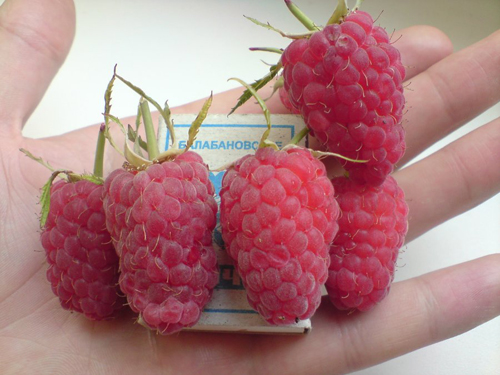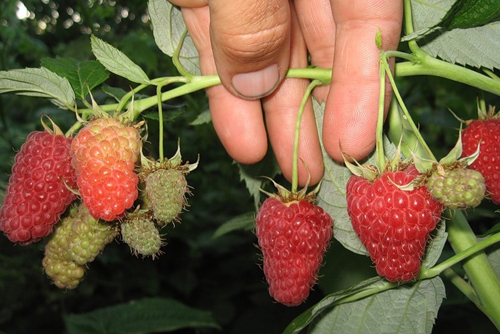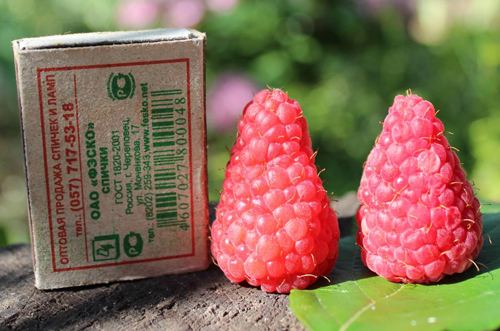Raspberry variety Patricia
There are many types of raspberries that are suitable and used for a variety of purposes. This is personal consumption, and the sale of fresh berries, and processing, freezing, or all this together. Soft, hard, aromatic, fresh, large, huge, small, tasty, sweet, sour - all varieties have fruits with different characteristics. And there are varieties "for the soul." With taste and aroma, like grandmother's raspberries in childhood, which you need to feast on right from the bush. Only the size of the berries in modern varieties is, of course, larger. Such is our heroine with the proud and beautiful name Patricia.

History of creation
This large-fruited summer raspberry was bred at the Institute of Horticulture and Nursery (VSTISP), located in Moscow. In 1986, the famous Russian breeder Professor V.V.Kichina crossed the Maroseyka variety and the M102 number form. In 1989, from experimental plantings, plants were selected that correspond to the characteristics of the new variety under the number K55. In 1992, he received the name Patricia, and its reproduction and implementation as a novelty has already begun.
Description
Raspberries are of medium early ripening, it starts from 15-20 July. In the southern regions, for example in the Kuban, it has sung from the beginning of July. The fruiting period is quite extended, up to two months.
The bush has good vigor, usually 6-10 stems. They are of medium thickness, erect, but semi-spreading, absolutely thornless, green in color with a slight waxy coating and pubescence. In the second year of life, they acquire a light brown tint. The shoots are tall, mostly 1.8-2 meters, with internodes of medium length. With good nutrition and the required amount of moisture during the growing season, the shoots reach 2.5-3 meters. The variety forms many lateral shoots. Laterals (fruit twigs) of raspberries are well developed, elongated, strong, branching from 2 to 4 orders of magnitude, each can have 15-20 fruits. The stems require cutting in height for easy harvesting, and cultivation using trellis or supports is desirable. Patricia produces quite a lot of root growth. The leaves are large, mostly five-leafed, oval, flat, deep green above, light below. The leaf blade is slightly pubescent, moderately wrinkled, the edges are sharply serrated.

Raspberry fruits are of a beautiful elongated-conical shape, with a blunt nose, bright ruby color, wide, fleshy, with a velvety surface and slightly pubescent. Drupes are small, homogeneous, tightly interconnected. The bones themselves are large, but there are few of them in the fruits. After ripening, the berries hang on the bush for a long time without crumbling. They come off easily from the fruit, do not crumble. But overripe fruits of Patricia in wet and cool weather quickly rot, and rot can spread to neighboring berries. Therefore, it is necessary to carefully select ripe fruits so that there are no outbreaks of disease. The berries are spectacular, large and very large, weighing 4-12 grams, can be poured up to a maximum of 18 grams. The average weight in the season is 8-10 grams. The length of the berries is 2.5-4 cm, but they often grow up to 5 cm (from a matchbox).
Often the largest berries are deformed or double-shaped. Especially in the first samples. There is nothing wrong with that. This also happens on other varieties and crops. For example, on a remontant blackberry with very large berries - Prime Arc Freedom. One of the reasons for this problem is extreme heat and dry air at the time of ovary and fruit development.
Among summer raspberries of domestic selection, the fruits of Patricia are one of the most delicious, they are sweet, juicy, very fragrant with a rich raspberry aftertaste. You can not just eat them, but “feast on” them. Our heroine is a variety for a gourmet, for tasting berries, as they say, "straight from the bush." The keeping quality and transportability of the fruits, how to put it more correctly, are disgusting.If the berries are cut directly from the stalk during selection, then they can still be transported over short distances. And so, during transportation, the fruits crumple strongly, lose their shape, give a lot of juice, in other words, they flow strongly. It is even advisable to recycle them at the place of collection, for example, at the dacha. Example - collected, cooked, poured into jars. And the beautiful and tasty jam is ready. Otherwise, you can bring home from the dacha a shapeless porridge, which will only be suitable for grinding with sugar.

The yield of Patricia is high, on average 4-5 kg of berries from a bush, but with good agricultural technology, the introduction of organic matter (in particular, rotted manure), productivity increases significantly - up to 7-9 kg. The total yield is 100-120 kg from one hundred square meters, but it can reach up to 250 kg. In the case of this raspberry, it is better to count productivity from a hundred square meters, since on an industrial hectare scale this variety is unlikely to be grown by someone. In the period of full fruiting strength, the plant enters the 3rd year.
The proven winter hardiness of the variety is up to -30 ° C, if there is a possibility of lower temperatures in winter, then it is necessary to bend and cover the shoots, for example, with agrofibre (lutrasil) with a density of 50 or thinner, but folded in half. Patricia does not like acidic soils. Abundant and regular watering is needed, especially during the fruiting period, otherwise the berry quickly becomes shallow and the flavor is lost. Fruits can be baked in the sun in extreme heat. Raspberries respond very positively to the introduction of organic matter, especially humus.
On some sites, especially those selling seedlings, our heroine is positioned as a remontant. Why not? Large-fruited, studless, tasty remontant. How not to sell ??? Once again we convincingly declare - this is a purely summer variety. But due to changes in climate, many plants, for which this is not typical, may show insignificant remontant in autumn. As well as strawberries of short daylight hours, blackberries, summer raspberries, etc. Patricia is no exception, on the shoots of which a few berries may appear in the fall.

Our heroine is resistant to the main diseases of culture (didimella, anthracnose), moderately resistant to botrytis (gray rot). But it is susceptible to a fungal disease - late blight. Therefore, it is recommended to carry out preventive spraying with fungicides in the spring before bud break and monitor the condition of the plants throughout the season.
Advantages of the variety
- Large and very large, sometimes even just huge berries.
- Straight-growing shoots without thorns, which makes plant maintenance and harvesting easier.
- Good yield.
- Wonderful sweet berry taste with raspberry aroma.
- Early ripening, extended fruiting, which allows fruit to be harvested regularly for almost two months.
- After ripening, the berries of Patricia do not crumble from the bush, they are easily separated from the fruit and do not crumble.
- Resistance to major raspberry diseases and high frost resistance.
Disadvantages of the variety
- Strong branching of lateral shoots, pruning and sanitary cleaning should be carried out regularly to avoid thickening.
- Deformation and bifurcation of large berries, especially at the beginning of fruiting.
- Overripe fruits quickly rot in cool and damp weather, Patricia is susceptible to late blight.
- Very low transportability and keeping quality of berries, one can even say about their complete absence.
- The purpose of raspberries is only for personal consumption and processing, preferably at the place of collection.
- Strong dependence of the taste and size of berries on regular and abundant watering, especially during the fruiting period.
Author: Maxim Zarechny.









I agree with the author of the article - this raspberry has really large, juicy and tasty berries, but in order to get the maximum yield from the variety, the shoots must be tied to a horizontal trellis. At first we ignored this recommendation, and the harvests did not impress us - yes, there were a lot of raspberries (as I thought then), until I saw what kind of harvest Patricia actually gives (I got to industrial plantations, saw bushes strewn with berries, and was shocked !). Now we have built supports for our raspberries, water well and be sure to mulch the plantings - the yield has increased significantly. In the variety I do not like only one thing - it is a large amount of root growth, I have to fight with it all season.
Indeed, Patricia's berry is both huge and tasty. Everyone who saw her fruiting here was greatly impressed. But, despite these advantages, this raspberry migrated to my parents at the dacha. The reason is the lack of portability. We planted it for sale, sold it to us as a remontant, but in practice it turned out that this is a real summer variety and we simply did not bring beautiful and large berries to the market.
There is only one conclusion: Patricia is perfect “for herself”. Anyone who plans to grow a beautiful berry for the market needs to look for another suitable variety.